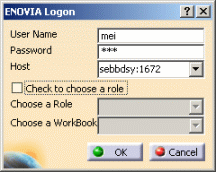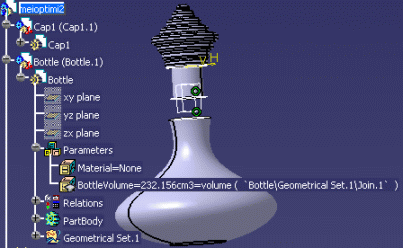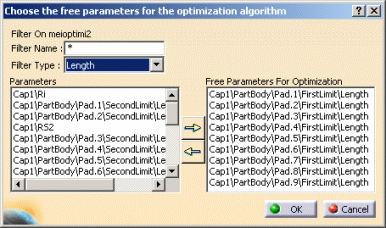- create a product in ENOVIA LCA and send it to CATIA
- add 2 components to the product and create a parameter at the product level that computes the total volume of the assembly
- add an optimization that will optimize the total volume
- save the product in ENOVIA LCA using VPM Navigator and send the product back to CATIA
- Make sure you have selected ENOVIAV5 in the View > Toolbars menu.
-
Create a Product in ENOVIA LCA. You can close ENOVIA LCA after creating the Product.
Send the Product to CATIA
-
To send the product to CATIA:
- In CATIA, click the Connect user to ENOVIA V5 icon
(
 )
in the ENOVIA V5 toolbar. The ENOVIA Logon dialog box
is displayed:
)
in the ENOVIA V5 toolbar. The ENOVIA Logon dialog box
is displayed:
- Enter your User Name, and your password.
- Select a "role" and a workbook and click OK.

- Click the Search ENOVIA icon (
 ).
The VPM Search dialog box is displayed.
).
The VPM Search dialog box is displayed.
- In the Objects scrolling list, select the Product option.
- Enter the owner's ID.
- Click OK when done. The Product ID is displayed in the Result window.
- Double-click the product that you want to load.
- Right-click the root product and select the Open command. The Open Modes dialog box is displayed:
- Leave the default settings and click OK. The CATIA view is displayed.
- In CATIA, click the Connect user to ENOVIA V5 icon
(
Add Components to the Product
-
Click the root product and select the Insert > Existing Component... command. Select the Kwobottle1.CATPart document. The bottle cap is inserted into the product.
-
Click the root product and select the Insert > Existing Component... command. Select the Kwobottle2.CATPart document. The bottle is inserted into the product.
-
Optional: Access the assembly design workbench to add constraints to the assembly.

Add a Volume Parameter to the Product
-
Create a Volume parameter that will compute the bottle total volume.
- Click the
 icon. The Formulas Editor opens.
icon. The Formulas Editor opens.
- Select Volume in the scrolling list. Click New Parameter of type.
- Edit the name of the new parameter (Total_Bottle_Volume in this scenario) in the Edit Name or value of the current parameter and click Add Formula.
- Enter the formula below and click OK when done:

- The new parameter is displayed under the Parameters node located below the Default-Technological package.1 node in the specification tree.
- Right-click the technological package and select the Properties command. Rename the technological package in the Name field (Optimization in this scenario), and click OK when done.
- Click the
-
From the Start > Knowledgeware menu, access the Product Engineering Optimizer workbench and click the Optimization icon (
 )
to create an optimization. The Optimization window is displayed.
)
to create an optimization. The Optimization window is displayed.- In the Optimized parameter field, click Select... and select the Total_Bottle_Volume parameter in the Choose the parameter dialog box. Click OK when done.
- In the Free parameters field, click Edit list...
and select the parameters (see graphic below.) Click OK
when done.

- Uncheck the Save optimization data check box.
- In the Constraints tab, click New... to add a
constraint and enter the following constraint body:
Cap1\Total_Volume > 189cm3. Click OK when done. - Click Run Optimization and click OK
when done. Click the Update icon (
 )
to update the Cap1 part.
)
to update the Cap1 part.
Save Data in ENOVIA LCA
-
Click the Save data in ENOVIA V5 icon (
 ).
The Save in ENOVIA dialog box is displayed. Check the Unlock All
option and click OK when done.
).
The Save in ENOVIA dialog box is displayed. Check the Unlock All
option and click OK when done. -
Close the product in CATIA.
-
Send your product back to ENOVIA (see Step 2).
- Click the Search ENOVIA icon (
 ).
The VPM Search dialog box is displayed.
).
The VPM Search dialog box is displayed.
- In the Objects scrolling list, select the Product option.
- Enter the owner's ID.
- Click OK when done. The Product ID is displayed in the Result window.
- Double-click the product that you want to load. The VPM Navigator view is displayed (see picture opposite).

- Right-click Optimization, Bottle.1, and Cap1.1 and select the Open... command. The bottle is displayed along with the associated technological package.
- Click the Search ENOVIA icon (
![]()